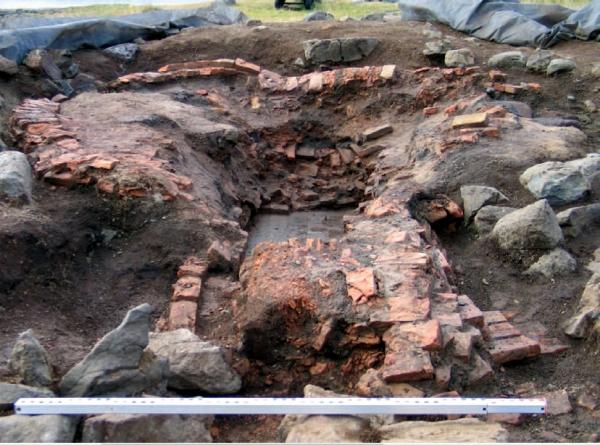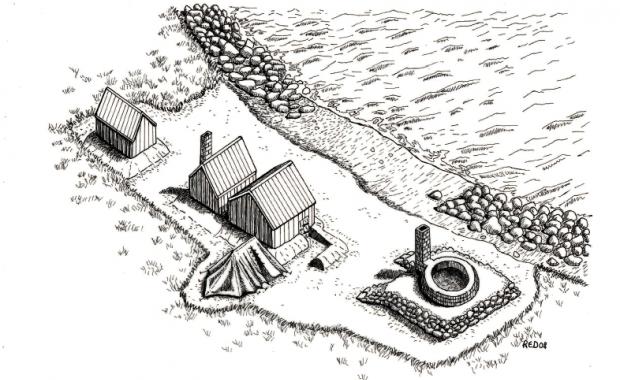If you are travelling in Strandir or North Western Iceland this weekend you should stop by at Steingrímsfjörður bay for a unique tour of a archeological site where the remains of a 17th century whaling stations are being excavated.
The tour, which is free and open to the public, is led by Ragnar Edvardsson, project manager at the University of Iceland. Ragnar, who is a specialist in coastal and marine archaeology, has been researching the remains of whaling stations in Strandir in the Westfjords.
Discoveries which rewrite Icelandic history
Ragnar tells us the site has raised numerous questions about Icelandic history:
First of all, it demonstrates that we had these bases, where large numbers of foreigners lived for long periods of time, at a time when Icelanders were forbidden by the Danish King from having any contact with foreigners, and foreigners were banned from entering the country.
The base, which was quite large, was in operation from 1610 to at least 1660. Ragnar believes that it was home to 20-50 whalers each year. It appears to have been originally built by Basques, but then taken over by Dutch or English whalers who gained control of whaling in the North Atlantic in the second half of the 17th century. In addition to this one station Ragnar has performed preliminary excavations at two other sites where he has found 17th century whaling stations in Strandir in the Westfjords.

Two unexplained mysteries
Ragnar tells us that the station raises two fascinating questions.
Considering the size of the station, it is a real mystery why it does not appear in any written documents from the time. There is absolute silence! Which is really strange, when you consider the fact that this was a operation on industrial scale.
The other question is perhaps more baffling:
It is clear that there were Icelanders who worked for the whalers, and it is unconceivable that they did not learn how to hunt and process whale. But Icelanders never take up whaling. It would have been easy for Icelanders to take over this station when it was abandoned by the foreign whalers, but they didn‘t do that.
It was only in the 20th century that Icelanders begin whaling. So, all talk of whaling being a important part of Icelandic tradition is just historical revisionism of the worst kind!
During the 17th century whalers from the Basque region in Spain had a significant presence around Iceland, especially in the Westfjords. The last and one of the most notorious massacres in Icelandic history took place in 1615, when 32 shipwrecked Basques were murdered in Reykjafjörður bay in the Westfjords, north of Steingrímsfjörður bay.
When and where?
The tour is free and will be offered in English, unless attendees are Icelandic, Ragnar tells us, in which case he will just stick to Icelandic.
The tour will take place at Strákatangi isthmus, by the farm Hveravík, on the northern coast of Steingrímsfjörður bay, across the bay from the village of Hólmavík.
If you are travelling in Strandir or North Western Iceland this weekend you should stop by at Steingrímsfjörður bay for a unique tour of a archeological site where the remains of a 17th century whaling stations are being excavated.
The tour, which is free and open to the public, is led by Ragnar Edvardsson, project manager at the University of Iceland. Ragnar, who is a specialist in coastal and marine archaeology, has been researching the remains of whaling stations in Strandir in the Westfjords.
Discoveries which rewrite Icelandic history
Ragnar tells us the site has raised numerous questions about Icelandic history:
First of all, it demonstrates that we had these bases, where large numbers of foreigners lived for long periods of time, at a time when Icelanders were forbidden by the Danish King from having any contact with foreigners, and foreigners were banned from entering the country.
The base, which was quite large, was in operation from 1610 to at least 1660. Ragnar believes that it was home to 20-50 whalers each year. It appears to have been originally built by Basques, but then taken over by Dutch or English whalers who gained control of whaling in the North Atlantic in the second half of the 17th century. In addition to this one station Ragnar has performed preliminary excavations at two other sites where he has found 17th century whaling stations in Strandir in the Westfjords.

Two unexplained mysteries
Ragnar tells us that the station raises two fascinating questions.
Considering the size of the station, it is a real mystery why it does not appear in any written documents from the time. There is absolute silence! Which is really strange, when you consider the fact that this was a operation on industrial scale.
The other question is perhaps more baffling:
It is clear that there were Icelanders who worked for the whalers, and it is unconceivable that they did not learn how to hunt and process whale. But Icelanders never take up whaling. It would have been easy for Icelanders to take over this station when it was abandoned by the foreign whalers, but they didn‘t do that.
It was only in the 20th century that Icelanders begin whaling. So, all talk of whaling being a important part of Icelandic tradition is just historical revisionism of the worst kind!
During the 17th century whalers from the Basque region in Spain had a significant presence around Iceland, especially in the Westfjords. The last and one of the most notorious massacres in Icelandic history took place in 1615, when 32 shipwrecked Basques were murdered in Reykjafjörður bay in the Westfjords, north of Steingrímsfjörður bay.
When and where?
The tour is free and will be offered in English, unless attendees are Icelandic, Ragnar tells us, in which case he will just stick to Icelandic.
The tour will take place at Strákatangi isthmus, by the farm Hveravík, on the northern coast of Steingrímsfjörður bay, across the bay from the village of Hólmavík.







